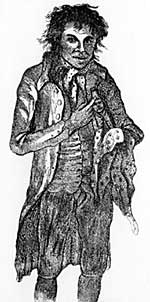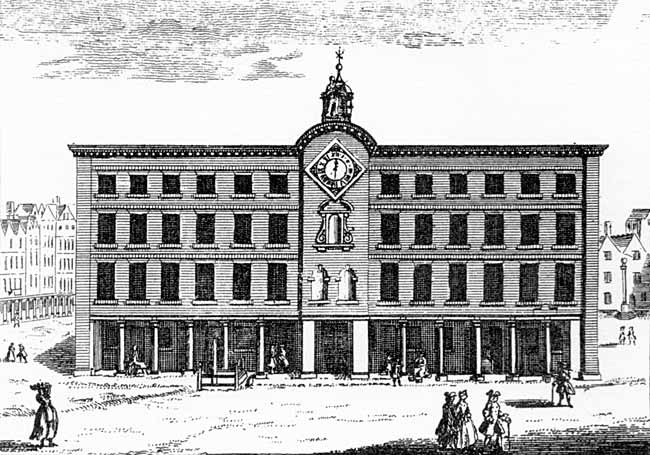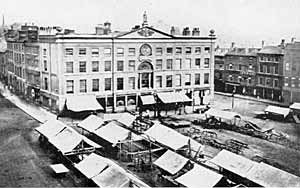< Previous | Contents | Next >
During the Commonwealth, while the position of the Church was so very difficult, banns of marriage were, at any rate upon one occasion cried from the Malt Cross in face of the market and the entry which gives us this information leads us to believe that it was by no means an isolated instance. Then again in 1635 Charles I. slept at "The Great House in the Market" which was probably either the "Crown" or "The Feathers Inn."
In 1794 there is a very curious entry which, speaking of the celebration consequent upon the King's birthday, refers to "a double quantity of coal for the annual fire in the market." This is the only reference to the annual fire that I have come across and I am quite at a loss to understand it.
It seems almost incredible to think that in 1779 a man sold his wife and children in the Market Place. The woman was aged seventeen and she with her two children was put up for sale and sold for 27/6, but that is not the worst. In 1852, the year in which the Arboretum was opened, another similar sale took place. On April 25th a man named Stevenson living in Millstone Lane brought his wife into Nottingham Market Place with a new rope round her neck and standing near the sheep pens on Beastmarket Hill, offered her for sale: "Here is my wife for sale" he announced, "I shall put her up for 2/6, the rope is worth 6d." Ultimately she was bought for 1/- by a man named Burrows, and they all went to the Spread Eagle which was in the old Sheep Lane which is modernised in the Market Street to sign the articles of agreement, the lady being the only member of the party who was able to sign her name,
Another curious episode in the market's history occurred in 1814. In the winter of that year there was a tremendous fall of snow and in order to clear the streets of the town this was all carted and dumped into the Market Place where it formed a huge stack forty yards long by twenty yards wide, so great a mass was there of this snow and ice that it lasted till the June of the following summer, and during the March Fair a great cavern was hollowed into it in which two abnormally large hogs were exhibited to an admiring public.

"Shelford Tommy", c.1790.
This seems to be a suitable opportunity to mention two curious crooks who amused our forefathers about 1790. One of them was called "Shelford Tommy" although his real name was James Burne. He was an itinerant ventriloquist and earned a precarious existence by giving exhibitions of his capabilities with an ill-made ventriloquial dummy. Many amusing stories are told of his powers, one of which was that seeing a waggoner with a load of straw he imitated the crying of a baby so naturally that the waggoner thought there was a child buried under his load and in all haste proceeded to unload his cart lest he should smother the child. Upon another occasion seeing a maid about to dress a fish he caused the fish to apparently call out "Don't cut my head off," which so alarmed the maid that she was seized with a fit and "Shelford Tommy" was seized by the constable and lodged in prison for his pains. "Whistling Charlie" was another strange character who used to dress himself up in all sorts of strange finery and attract the notice of charitably-minded folk by playing sometimes on the lute and sometimes on a horn and sometimes upon a whistle.
Another type of man who visited Nottingham Market Place during the 18th century was the great John Wesley who in 1741 and again in 1743 preached in the Market Place. His brother Charles Wesley preached there in 1743 and 1744, while John Nelson, surely one of the most heroic evangelists whom the Christian Church has ever produced and whose autobiography is as fascinating a book as it is possible to come across, was here in 1743 and 1745; while George Whitfield himself preached here in 1749 and 1750.
The first regular cab stand in Nottingham was set up on the Long Row in 1845, and it was not until 1908 that the first taxi which appeared in Nottingham had started operations by joining the rank on Long Row on the morning of February 17th in that year. Of modern events in the Market Place, electric light was first used in 1894 and Queen Victoria's statue was unveiled in 1905.
And now let us consider in detail some of the buildings which flank the Great Market Place. The Exchange was, until 1926, of course, the most noticeable of these. It has now all disappeared and we shall have nothing in the future to show us its appearance or to remind us of its history. That history is not particularly absorbing, and as Nottingham's story goes, is not of any very great importance.

The Exchange in the mid-18th century.
In 1713 the last vestige of the difference between the English borough and the French borough had been swept away and the authorities doubtless felt that it would set a seal upon the union of the two towns if instead of having to support two Moot Halls, the one on High Pavement and the other in Friar Lane, they constructed a single hall and set of offices which would accommodate the whole town, consequently in 1724 the New Exchange, as it was called, was commenced.

The Exchange, c.1910.
Up till that time as we have seen the shambles and other buildings extended westward into the market to about where the entrance to the old Exchange Hall stood until 1926. The dark shambles were towards the Poultry, the light shambles towards Smithy Row, and the Spice Chamber was over the latter. Mr. Marmaduke Fennel who was Mayor of Nottingham at the time and who was also an architect was in charge of the building which cost £2,400. In order to accommodate it a slice was cut off the Market Place extending to the full width of the New Exchange westward, and in order to provide an imposing facade the Shoe Booths were included in its total length as we have already seen. It was a plain brick structure of no great architectural merit, but typical of the times. In the course of its demolition it has been found that it was not particularly solidly built, but at any rate it lasted for a couple of hundred years. Its main front facing the market was 123 feet long. Its ground floor was formed by a piazza 17 feet deep which matched the other piazzas round the Market Place. Above this were three niches which were intended to carry statues of George I. and the Prince and Princess of Wales, but these were never completed. There was a clock made by a man called Woolley of Codnor in its gable. Woolley has a curious story. In his early youth he was extremely fond of shooting, but in those days the use of firearms was forbidden to anybody of a lesser estate than £100 per annum. Being arrested with a gun in his possession he got into trouble, which so much annoyed him that he decided that he would never stop work, except when prevented by natural causes, until he had accumulated sufficient fortune to entitle him to carry firearms. Accordingly he set to work with feverish eagerness, snatching at his meals as he worked and only allowing himself to sleep when nature refused to allow him to remain awake. For years he persisted in this cause until at last he was of sufficient fortune to fulfil his cherished desire, and then to his dismay he found that his love of sport had completely evaporated and the only thing in the world that interested him was his work, while the idea of a holiday in any shape or form was utterly distasteful to him.
